Photographs: Reuters Rediff Business Desk
China's high-speed rail project is the biggest transportation infrastructure plan in human history and it is transforming the Chinese landscape.
At a dizzying pace, Beijing has managed to bring to fruition its long-cherished dream of having a modern, super high-speed train system that criss-crosses the nation and is able ferry millions of passengers slashing travel time by over 60 per cent.
In just a few years, the Asian giant has managed to lay down over 5,000 km of new high-speed rail lines. And the plan is to expand it further . . .
Large sections of China's population are becoming more mobile, remote regions of the country are opening up, and Chinese businesses are racing to meet under-served consumer demand.
. . .
How China's bullet trains are powering its economy
Photographs: Reuters
A new Morgan Stanley study by Jerry Lou and Allen Gui explains how the ultra-fast bullet trains will change the Chinese economy forever.
High-speed rail is the key to China's balanced, sustainable double-digit growth. By 2020, four super-city clusters will emerge in China and two existing super-cities will expand as a direct result of the population's increased mobility and the surge in domestic traffic in China.
A more mobile workforce and newly accessible markets will serve to narrow the country's geographic and economic disparities.
The impact is imminent . . . by 2013, 50 per cent of the cities on the planned network will be connected to the high-speed rail grid. The economic impact of this increased connectivity will continue well beyond the immediate gains in key industries, however.
. . .
How China's bullet trains are powering its economy
Photographs: Reuters
Some industries are clearly well placed to derive long-term benefits from China's infrastructure build-out.
Morgan Stanley analysts, from 12 industries and three continents, have identified the opportunities associated with this mega project.
The global investment bank has created geographic and sector baskets based on its investment analysis, which it believe will capture the secular opportunity in China for the coming 10 years, especially in hotels, restaurants, tourism, car rental, property, and rolling stock. However, aviation and toll roads may not fare as well, claims the Morgan Stanley report.
How high-speed rail is reshaping Chinese economy
China's ever-expanding high-speed rail system is transforming the country, both, economically and socially.
. . .
How China's bullet trains are powering its economy
Photographs: Reuters
Over the next decade, China's high-speed rail system will increase the mobility of the population, affecting some 70 crore (700 million) people; contribute to the creation of four new super-city clusters, and enhance two existing super-cities; and boost hub cities' traffic exponentially.
The high-speed rail system is the solution to China's growth sustainability. A more mobile work force and more-accessible markets will narrow the country's geographic and economic disparities.
Structural changes are imminent, but the economic impact is long term.
Over the next few years, China's high-speed rail will take shape quickly. Investors, says the Morgan Stanley report, must understand the imminent structural changes and take positions today.
. . .
How China's bullet trains are powering its economy
Photographs: Reuters
Morgan Stanley's investment strategy on China's high-speed rail focusses on the following at the regional level:
Western and Central China; and
The most rapidly rising hub cities.
At the industry level, it focusses on:
Near-term immediate beneficiaries -- railway infrastructure and rolling stocks industries;
Mid-term beneficiaries -- leisure/lodging and properties;
Long-term beneficiaries -- consumer staples and consumers 'discretionaries'.
China, the most populous country in the world, will soon set another ground-breaking record: in the coming decade, its high-speed rail system, currently under development, will become the largest in the world.
. . .
How China's bullet trains are powering its economy
Photographs: Reuters
Morgan Stanley says that development will be no less economically significant than China's urbanisation story.
And here is why it believes the Chinese economy will continue to outperform:
The China high-speed rail system will span 30,000 km, connect more than 250 cities and regions with a total population of about 700 million, mobilise 400 core (4 billion) travellers per year, and add 1,600 billion km to China's domestic passenger throughput annually (i.e., four times the total domestic passenger throughput in Japan today) by 2020.
At peak speed, the high-speed rail grid can support speeds of 350 km per hour, increasing commuting efficiency many times over.
. . .
How China's bullet trains are powering its economy
Photographs: Reuters
Large, existing, stand-alone cities in the same region will see their boundaries merging to create connected metropolises, boosting secular service industry demand and creating new business opportunities in the consumer, leisure and lodging, and property sectors.
The investment bank calls these merged cities 'super-city clusters' (SCCs) and predicts that four new SCCs will emerge and two existing SCCs will expand in the coming 10 years.
Many economically challenged cities in west and central China will be revitalised because of the hub effect created by the high-speed rail system.
Some cities will even see passenger flow growing by as much as 10 times in the coming decade, making them strategically important targets for many industries such as hotel, catering, logistics, and properties.
. . .
How China's bullet trains are powering its economy
Photographs: Reuters
Geographic and economic rebalancing
Despite its rapid economic growth in the past few decades, China still faces bottlenecks in the distribution of its wealth, with a marked imbalance between the geographic development of the coastal areas and that of inland and western China.
Indeed, this geographic imbalance has been worsening as the coastal areas continue to develop at a much faster rate than do the inland and western regions.
Until now, most of China's economy vibrancy has been trapped on the eastern and southern coasts of China, and as one travels across the region, the huge asymmetries in economic development make different cities look more like different countries.
. . .
How China's bullet trains are powering its economy
Photographs: Reuters
Those who visit Shanghai-centered coastal China, for instance, will find this region more like well-developed countries such as the United States and Europe and less like central and western China, even though the coastal region and the central/western regions occupy the same continent.
While regional economic differences are not rare in a global economy, China's regional differences are by far the most disparate of any in the world.
The high-speed rail network will tap this geographic-economic imbalance in an unprecedented and aggressive fashion by improving market access, encouraging population mobility, and enhancing logistics efficiency.
Morgan Stanley said in the study that it expects to see lifestyle changes among the population, which in turn will stimulate innovation and creativity and lead to the creation of new businesses in the long-term.
. . .
How China's bullet trains are powering its economy
Photographs: Reuters
The study said that by 2015, city clusters with travel radii of three hours would start to take shape in China. By 2020, there will be six such city clusters taking shape, overlapping with each other throughout most of China except the northwest and southwest.
These city clusters will cover about 70 per cent of the Chinese population and account for about 75 per cent of China GDP.
The study also said that by 2025 all of these city clusters would be so mature that the regional economic differences in China will narrow to Western economy levels.
According to the investment bank's 'rough estimates', the parts of China that lag behind (central and western China) collectively will be growing at a rate of 15% real GDP in the coming 10 years, compared with their more-developed coastal peers.
Commercial and residential real estate value in the currently lagging cities covered by these city clusters will receive strong support from the launch of new high-speed rail lines.
. . .
How China's bullet trains are powering its economy
Photographs: Reuters
Timeline: Investors should build positions today
Because China's high-speed rail grid has 10 years more in its construction life cycle, Morgan Stanley is analysing the economic impact of HSR over a 10-year timeframe.
Nevertheless, the investment case is, in fact, imminent: The high-speed rail grid will take shape quickly over the next few years, so investors should take positions today, says the Morgan Stanley report.
According to the national high-speed rail construction plan and our own modelling, more than 50 per cent of cities planned for the high-speed rail grid over the next 10 years will be connected before 2013.
Addressing the concern: Profitability and sustainability
Will the China high-speed rail project be sustainable? This is clearly a valid question to ask. The operating capital required for such a mega project will be substantial.
. . .
How China's bullet trains are powering its economy
Photographs: Reuters
Morgan Stanley transportation analyst Edward Xu and capital goods analyst Kate Zhu believe that on average every 1,000 km of China high-speed rail will require Rmb4.5 billion per year in operating cash to function (this includes maintenance, parts replacement, and day-to-day operational costs).
On the other hand, the operating revenue, based on our ticket price estimate (using the same per-thousand-kilometre price to per-capita GDP ratio on the eastern portion of the national grid), per-thousand kilometre revenue will be around Rmb6.5 billion per year.
This translates into a national operating cash surplus of Rmb2 billion per year, which should be able to cover most, if not all, of the interest expenses.
The funding capabilities of the Chinese government too need to be looked at. The high-speed rail will create substantial new passengers flow, generate new business opportunities, and raise asset prices (such as land and properties).
All these will mean higher fiscal revenue for the local governments. It is estimated that at the national level, every 1,000 km of high-speed rail will create at least Rmb2 billion per year in new fiscal revenue. This is more than enough to close the high-speed rail funding gap.
. . .
How China's bullet trains are powering its economy
Photographs: Reuters
Thus Morgan Stanley analysts conclude that the high-speed rail will create enough economic value to keep itself financially sustainable.
HSR's sector investment implications
As the high-speed rail grid builds out quickly in China, its scale and logistical significance will start to create new business opportunities.
So how big would such business opportunities will be?
Among the sectors where opportunities will arise, according to Morgan Stanley, are:
- Budget hotels;
- Restaurant and catering;
- Tourism (theme parks, resorts, and agencies);
- Consumer staples;
- Retailers and brands;
- Car rental;
- Commercial and residential properties;
- Railway infrastructure; and
- Capital goods and rolling stocks.
. . .
How China's bullet trains are powering its economy
Photographs: Reuters
Not surprisingly, the high-speed rail grid is also expected to pose new challenges to existing logistics forms:
Aviation
The aviation industry in China is likely to feel the heat once the high-speed rail projects are complete. Regional jets will have limited market potential in China and will do well only in those regions where the HSR will not reach, such as the northwest and southwest, assesses Morgan Stanley.
Airlines also will face tough competition on existing regional routes where HSR capacity will increase and divert passenger traffic.
Analysts believe that HSR would be competitive for airlines at a distance of 800-1,500 kilometres and highly competitive at a distance of 800 kilometres.
Because regional jets are usually targeting short- to mid-haul distances between 500 and 600 kilometres, it faces high risk from HSR on overlapping routes.
. . .
How China's bullet trains are powering its economy
Photographs: Reuters
Toll roads
The competition that HSR poses to toll roads will be much smaller than that to airlines due to HSR's expensive ticket price and lack of convenience for short-distance travel.
Analysts expect 1-3 per cent passenger traffic dilution in 2011-13 from toll road to HSR. Furthermore, as HSR can free up cargo capacity in traditional railway system, the potential movement of cargo traffic from toll roads over to traditional railway is likely to be material.
Meanwhile, Morgan Stanley forecast a 10-12 per cent cargo traffic dilution from toll road to traditional railway by 2015.
Other countries' cases turn to support our findings. Japan and the US experiences suggest that the construction of rapid-transit systems led to the urbanisation of local communities, boosted demand of commercial premises, and shored up regional economies.
In addition, passenger railway networks such as the high-speed rail system are expected to have significant positive impact on property values.
On the other hand, history shows the operation of high-speed rail could take substantial market share from conventional operators.
Europe and Japan observed severe blows to their airline traffic from high-speed rail on overlapping routes below 800 km.

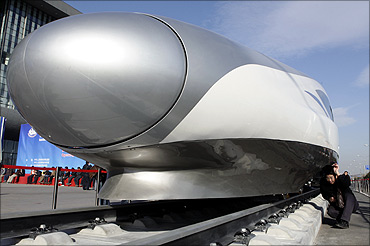

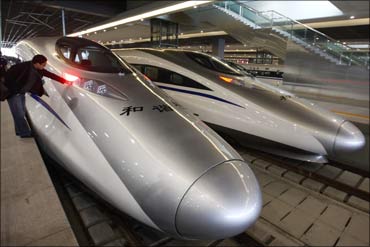
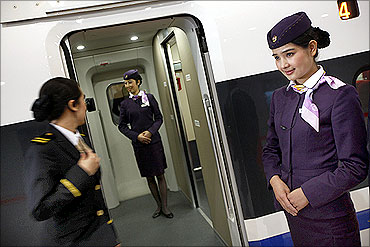

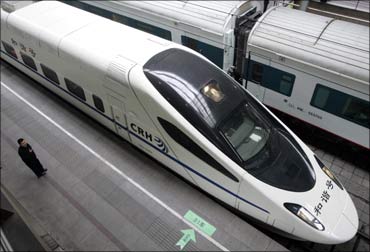
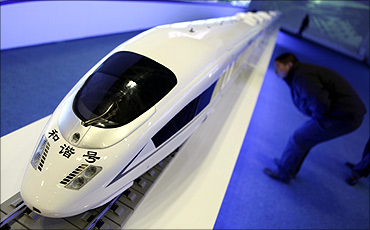
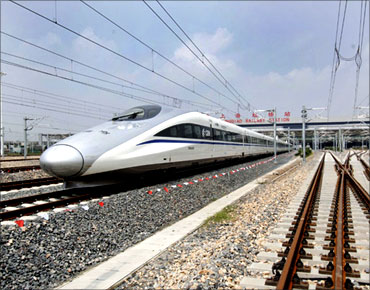

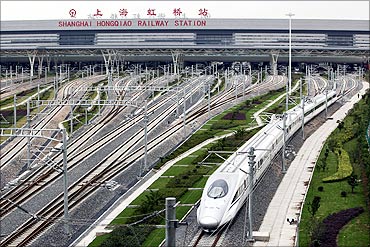
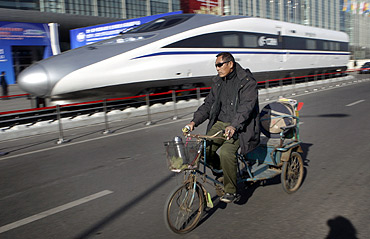



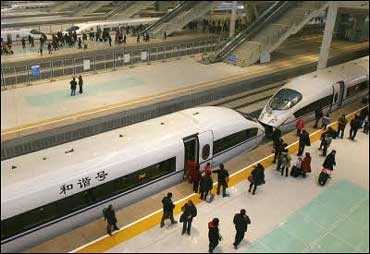
article